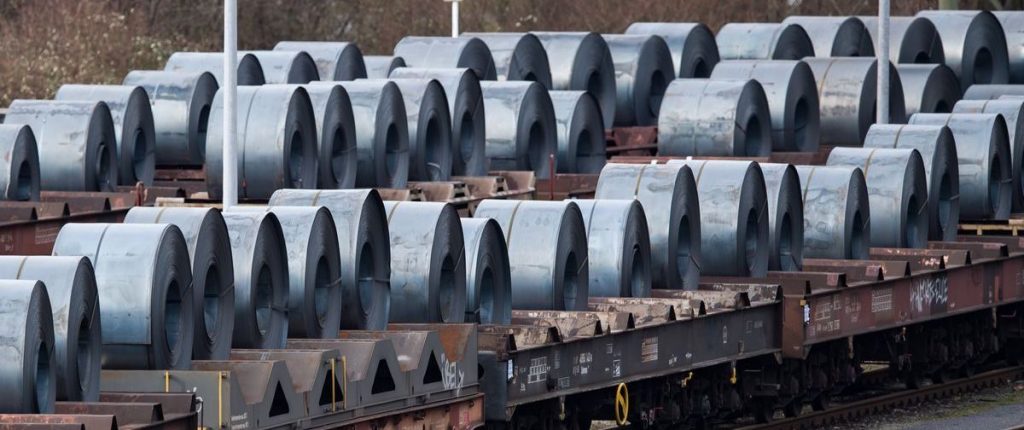The U.S. government’s steel and aluminum tariffs went into effect — and they have already created an international furor. So mission number one is accomplished. The tariffs were intended to upset the applecart of an obsolete world trading system that is politically dangerous and economically disastrous.
[Jeff Ferry | June 2, 2018 | The Hill]
But there is more to do.
First of all, it must be understood that these tariffs are aimed at redressing U.S. national security and they are a response to a serious decline in U.S. production and capacity in these two industries.
Worldwide overproduction and overcapacity in both metals have undermined the U.S. industries. There is an estimated 400 million tons of excess steel capacity in the world (about 25 of total capacity).
That has hurt the U.S. industry badly in terms of price, profit, and employment. The situation in aluminum is even worse. In 1993, the U.S. had 23 operational aluminum smelters. Today it has five. Some 90 of primary aluminum consumed in the U.S. is imported.
Both metals are the very heart of national security. Steel is of course used in every aspect of the military, including land vehicles, seagoing ships, missiles, guns, and more.
Equally important: Steel is an essential component of our civilian infrastructure for use in ports, bridges, and the auto industry, to name just a few. The same goes for aluminum, a metal prized for its light weight and electrical conductivity. Aluminum is used in aerospace, in the automotive industry, and as a key component in our national electrical grid. No nation can claim to be a superpower if it is not self-sufficient in these two vital metals.
The tariffs have already had a positive effect on the U.S. economy. In Ashland, Kentucky, Braidy Industries broke ground on a new aluminum rolling mill. The mill, a $1.3 billion project, will create 550 new jobs.
Those workers will earn average annual pay of $65,000, in a depressed Appalachian county where the median pay is around $44,000 a year. Elsewhere in Kentucky, Century Aluminum is preparing to hire 300 more workers as aluminum demand rises.
On the steel side, Nucor is planning to open a new $240 million steel mill in central Florida, creating 250 jobs, while U.S. Steel is restarting production and rehiring 500 laid-off employees in Granite City, Illinois.
European misunderstanding and confusion
The Europeans are up in arms. European Union Trade Commissioner Cecilia Malmstrom has called the U.S. tariffs a “dangerous game” and told BBC News, “We cannot just take these tariffs and stay silent.” The EU is reported to have prepared a 10-page list of potential tariffs they could impose against U.S. goods. There are three points I would make to my good friends in Europe.
First, the steel and aluminum tariffs are not directed at the European nations, nor any other nations. They are designed to ensure that the U.S. has the capacity to produce the steel and aluminum it needs. Loss of capacity in the last 20 years has been a very real problem for U.S. industry. To rebuild capacity, we need a U.S. market in which companies can earn a decent profit. Tariffs are the simplest way to achieve that end.
Secondly, in spite of the Malmstrom chaos and other rash statements emanating from European capitals, the Europeans actually do quite a good job of safeguarding their own steel industries. The three major European steel producers, Germany, France, and Italy, all operate their steel industries to ensure that net imports are very close to zero. In other words they run their industries at very close to self-sufficiency. The U.S. is simply seeking to do the same.
Finally, the European leaders are living in the past. As a French actress said, “Nostalgia isn’t what it used to be.” And neither is the world of trade. The Europeans would like to go back to the harmony of the 1950s, when free trade did indeed lift many boats, including the boats of the U.S. and western European economies.
But today, China’s huge economic, political, and military potential is changing the fundamental equation. Overcapacity in both industries has been caused by China’s relentless effort to expand production and dominate these two industries, among other critical industries too. We need a new solution to deal with this problem. We simply cannot allow one nation to drive other nations out of essential industries.
That’s why upsetting the applecart is a great starting point. The European Union is an organization dedicated to meetings, talking shops, and bureaucracy. But those talking shops, including the World Trade Organization, the G7, the G20, and the EU, cannot force change when one large nation (China) feels no pressure to change. The U.S. has to take the lead.
U.S. unilateral action is not only working to improve our economy. It will force change on the international community in a way that 100 years of talking would not do. President Trump’s tariffs are winning support in Congress on both sides of the aisle. The industrial benefits will win further support in the heartland. While this president may sometimes appear isolated, there is large and growing support for his positions on trade.
Surprisingly enough, even the director-general of the World Trade Organization, Roberto Azevedo, is beginning to see which way the wind is blowing. On Thursday in Paris, he told the press: “you could say that the shake-up in the global trade debate has been positive…People are talking about these issues again. They are testing old certainties, revisiting assumptions, and questioning how rules and institutions can be improved.”
The next decade will be very interesting times in the world of trade.
Jeff Ferry is research director for the Coalition for a Prosperous America (CPA), which is an organization that advocates on behalf of U.S. manufacturing, agriculture and labor.













